Space Shuttle
 From Conservapedia
From Conservapedia The Space Shuttle, officially the Space Transportation System (STS) was an American space travel vehicle, designed to be capable of multiple flights. The shuttle was developed by the National Aeronautics and Space Administration (NASA). Missions on the shuttle last for up to two weeks, and carry five to seven astronauts. The shuttle is the first space vehicle designed to be reusable.[1] The Space Shuttle system consists of three components,
- Two reuseable solid rocket boosters which (and will provide the main launch vehicles under the new Ares Launch program that follows the shuttle) provide nearly 80% of the thrust at takeoff
- The rust-colored External Tank, which feeds fuel to three Space Shuttle Orbiter Main Engines
- The orbiter itself, of which there are 3 operational. The Orbiters are reused but are extensively refurbished after each flight.
The longest space shuttle mission was 17.5 days on mission STS-80 in November 1996. Normally, missions are planned for anywhere from five to sixteen days in duration. The smallest crew ever to fly on the Shuttle numbered two people on the first few missions. The largest crew numbered eight people. Normally, crews may range in size from five to seven people. The Shuttle is designed to reach orbits ranging from about 185 kilometers to 643 kilometers (115 statute miles to 400 statute miles) high.
NASA intends to close out the service life of the space shuttle program by completing work on the International Space Station by 2010, then switch over to the Orion class crew transport vehicle, using tried-and-true space capsule concepts from the 1960s which are designed to emphasize crew safety.
The Soviet Union worked on a space shuttle project as well known as the Buran program. The Buran program was canceled due to lack of funding and the declining political situation. The Buran shuttle was launched into orbit in an unmanned test flight that succeeded however it did not fly again. One Buran orbiter was destroyed in 2002, when its hangar collapsed.
American Space Shuttle Program[edit]
| Image | Designation / Name | Namesake | First Flight | Last Flight | Current Status | Remarks |
|---|---|---|---|---|---|---|
| OV-101 Enterprise |
Originally to be named Constitution, she was instead named for the fictional starship of the television show Star Trek as a result of a large write-in campaign.[2] | February 15, 1977 | October 26, 1977 | On display at the Space Shuttle Pavillion, Intrepid Sea, Air & Space Museum Complex, New York City[3] | Used for atmospheric test flights and landings; did not fly into space. | |
| OV-098 Pathfinder |
- | No flights made | On display at the US Space & Rocket Center, Huntsville, Alabama | A full-sized replica used for various ground-handling procedures.[4] | ||
| OV-102 Columbia |
Named for an American sloop involved in the discovery of the Columbia River in what is now the western United States, 1792 | April 12, 1981 | January 16, 2003 | Lost on descent; crew killed, February 1, 2003 | First of the space shuttles to fly into space. | |
| OV-099 Challenger |
Named for HMS Challenger, a British research vessel during the 1870s[5] | April 4, 1983 | January 28, 1986 | Lost on ascent; crew killed | Originally built for Earth-bound tests, but later converted for space flight.[6] Last flight carried Christa McAuliffe, a New Hampshire high school teacher selected to be the first such individual under President Ronald Reagan's Teacher in Space Project. | |
| OV-103 Discovery |
Named for the ship which carried Henry Hudson on his search for the Northwest Passage, as well as the second ship commanded by British explorer Captain James Cook in 1770's [7] | August 30, 1984 | February 24, 2011 | Retired | On display at the James S. McDonnell Space Hangar, Steven F. Udvar-Hazy Center, Chantilly, Virginia[8] | |
| OV-104 Atlantis |
Named for the primary research vessel operated 1930-1966 by Woods Hole Oceanographic Institute, Massachusetts[9] | October 3, 1985 | July 8, 2011 | Retired | On display at the Kennedy Space Center, Merritt Island, Florida[10] | |
| OV-105 Endeavour |
Named for the first ship commanded by British explorer Captain James Cook in 1768 [11] | May 7, 1992 | May 16, 2011 | Retired | On display in the Samuel Oschin Pavilion, California Science Center, Los Angeles[12] | |
Tragedies[edit]
Sadly two space shuttles have been destroyed, killing all of the crew. Challenger was destroyed on ascent January 28, 1986 due to O-ring failure on one of the external main boosters, and Columbia disintegrated during re-entry on February 1, 2003, as a result of thermal tile loss to one of its wings.
References[edit]
- ↑ How The Space Shuttle Works
- ↑ Shuttle Enterprise at Center of Museum's Space Hangar
- ↑ https://www.intrepidmuseum.org/Space_Shuttle_Pavilion
- ↑ Pathfinder
- ↑ http://science.ksc.nasa.gov/shuttle/resources/orbiters/challenger.html
- ↑ Space Shuttle Overview: Challenger (OV-099)
- ↑ http://science.ksc.nasa.gov/shuttle/resources/orbiters/discovery.html
- ↑ https://airandspace.si.edu/collection-objects/space-shuttle-discovery/nasm_A20120325000
- ↑ http://science.ksc.nasa.gov/shuttle/resources/orbiters/atlantis.html
- ↑ https://www.kennedyspacecenter.com/explore-attractions/shuttle-a-ship-like-no-other
- ↑ http://science.ksc.nasa.gov/shuttle/resources/orbiters/endeavour.html
- ↑ https://californiasciencecenter.org/exhibits/air-space/space-shuttle-endeavour
Categories: [Space Exploration]
↧ Download as ZWI file | Last modified: 02/15/2023 09:10:04 | 13 views
☰ Source: https://www.conservapedia.com/Space_Shuttle | License: CC BY-SA 3.0
 ZWI signed:
ZWI signed:
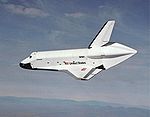
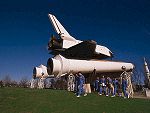
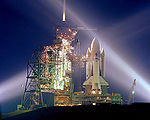
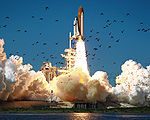
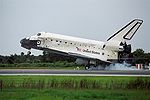
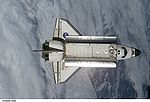

 KSF
KSF